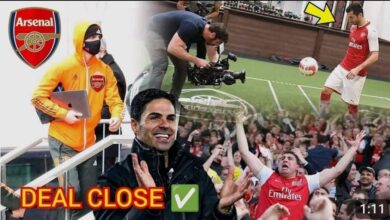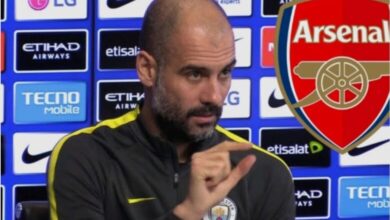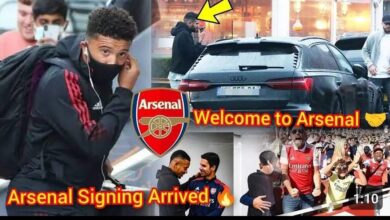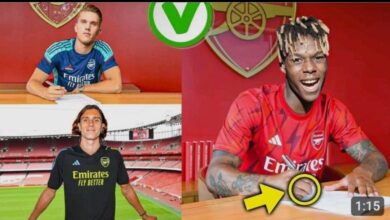How signing Lionel Messi will impact Inter Miami, MLS and American socce
How signing Lionel Messi will impact Inter Miami, MLS and American socce

The man who transformed the league as a player with LA Galaxy received a video greeting from Lionel Messi on his Instagram account when David Beckham and his Inter Miami partners won MLS’s 25th franchise in late January 2018.
After congratulating Beckham on the new endeavor, Messi said, “Who knows, maybe in a few years you will give me a call.”
Despite bids from Saudi Arabia and Barcelona, Messi’s video message has finally been fulfilled six years later with the announcement that he will sign with Inter Miami.
However, bringing the Argentine superstar to the United States required much more than a simple invitation. For the recent World Cup champion, who many consider to be the best player in the history of the sport, Miami and MLS have offered a king’s ransom. According to reports, Messi will receive a portion of the MLS and Apple broadcast deal, and Adidas, one of the league’s founding partners, is reportedly contributing money to bring the Argentine to Miami. He will undoubtedly receive the largest salary of any player in MLS history.
Messi’s transfer to Miami was the most dramatic and uncertain player trade in MLS history. Miami’s ownership has never wavered in their interest over the last six years. In 2021, Inter Miami co-owner Jorge Mas told The Athletic, “David and I are working very hard at making something like that happen, which I think is not only transformational for Miami, but I think for the league.”
Across MLS, others mirrored his sentiment. The league’s commissioner, Don Garber, said in March that the league was prepared to get creative to lure Messi, a once-in-a-lifetime talent.
Miami, of course, were not the only ones interested. Paris St-Germain made their own attempts to keep Messi, and Barcelona made a play as well. Maybe the biggest threat to any MLS deal came from Saudi Arabian side Al-Hilal, who offered a reported $400 million per year for Messi’s services.
In the end, Messi chose MLS.
Pele acknowledges the crowd in Giants Stadium.
Messi’s arrival in the U.S. will be the latest in what has been a trend of transformational footballers advancing American soccer with their presence, starting with Pele in the 1970s and continuing with Beckham in the 2000s.
No single player in the history of American men’s soccer has had as seismic an effect on the trajectory of the game in this country as Pele. The Brazilian legend famously joined the New York Cosmos of the nascent North American Soccer League in 1975. The Cosmos, backed by the corporate might of media empire Warner Communications, were seeking to do what no other soccer club in American history has ever done: make soccer truly, deeply relevant in this country. For a brief time, it appeared as though they might succeed.
Pele’s mere presence with the Cosmos certainly had some short-term benefits: the club’s average home attendance increased from around 3,500 fans in 1975 to around 45,000 by the time of his departure after the 1977 season. Three times, the Cosmos drew over 70,000 fans to watch Pele at Giants Stadium, an unheard of feat in that era. Think about it this way: after his departure, there were some teams in the league whose attendance for an entire season was lower than what the Cosmos drew for a single game during Pele’s tenure.
Away matches featuring the Cosmos became featured attractions; his presence attracted other giants of the game to the NASL — George Best, Johan Cruyff, Franz Beckenbauer, Gerd Muller and more. What Pele could not do, however, was save the NASL. His outsized impact on the Cosmos inspired an upward trend in spending that would eventually contribute to the demise of the league in 1984.
Pele’s impact, beyond a shadow of a doubt, was generational. In the 1970s, when Cosmos president Clive Toye approached the Brazilian in an attempt to lure him to the States, he made a fairly simple pitch — you’ve won many games and many trophies. In the United States, you have a chance to win an entire country over and be a soccer missionary.
In a way, it worked. Though the NASL collapsed, the kids who watched Pele during his three-year stay in the United States became the U.S.’s first great generation of soccer players, the pioneers who qualified for the 1990 World Cup and featured four years later in the 1994 edition of the tournament on home soil. From the wreckage of the NASL, the founders of Major League Soccer — some of whom had also owned NASL clubs — learned their own lessons. They chose a more reasonable path of financial prudence, one that helped keep the league alive for nearly twice as long as the NASL ever existed
Beckham waves to fans after playing his last game for LA Galaxy.
All of this meant that when Beckham arrived in MLS in 2007, the league was better equipped to make the most of their new global superstar than the NASL ever was. That season, the league had 13 teams, just three more than its inaugural season in 1996 — including newcomers Toronto FC, who paid a $10 million (£8.7m) expansion fee to join MLS — and an average league-wide attendance of 16,770 (over three million in total).
In 2023, MLS has 29 teams — including newcomers St Louis City SC – with a 30th on the way in San Diego.
That supercharged growth is largely thanks to Beckham.
“Without doubt, MLS has more global awareness than at any other time in our history and has more legitimacy in the United States because of David,” MLS commissioner Don Garber told the New York Times in November 2007. “Every measure of our business has grown because of him. We have sold more than 300,000 Beckham Los Angeles Galaxy jerseys, which was 700 times the number of Galaxy jerseys sold in 2006. Merchandise sales overall have gone up two or three times. International TV sales have gone up from next to nothing to distribution in 100 countries, with live games in Asia and Mexico.”
Messi’s presence in MLS could potentially have a similar effect on league-wide attendance, international exposure, merchandise sales and in attracting other talented players as Pele and Beckham before him, even though he is joining a league that’s in a stronger position than either of his predecessors. It is difficult to imagine that any MLS stadium would not be full to watch a man that many peg as the greatest player in the history of the game. If anything, MLS’ soccer-specific stadiums, many of which hold 18,000 to 30,000 people, might not be big enough to maximize gate revenue when Messi comes to town, given that crowds of 60,000 to 80,000 turned out to see Messi on a Barcelona pre-season tour in 2017.
It feels possible that some MLS clubs would consider hosting Inter Miami matches in larger venues – local NFL or college stadiums – though that remains to be seen. It’s also a tricky calculus. Do those teams surrender a potential home field advantage in exchange for a cash windfall? Prices on the secondary market for Miami matches across MLS have already begun to rise.
MLS clubs could also simply raise the prices of the seats in their undersized stadiums to match demand, something that feels entirely possible.
The economic impact Messi would have on Inter Miami alone is its own story.
If the numbers PSG reported during Messi’s stay in Paris were any indication, Inter Miami will become among the most popular brands in American sports. According to a report from Marca, PSG generated €700million in revenue over the course of one year after his arrival.
The report cites an investigation by Argentine outlet El Economista, which reported that since Messi joined the club, PSG had added 10 new sponsorship deals ranging from €3m to €8m each. Image rights and match day sales also skyrocketed, as did demand for Messi’s No. 30 PSG shirt. In July 2021, Diario Ole in Argentina revealed that only Real Madrid had sold more shirts than PSG since Messi’s arrival in France, with 60 percent of PSG shirts sold being Messi’s.
On social media, PSG saw its following increase astronomically. PSG gained 5.6 million followers the week after announcing Messi’s signing and have since added 15 million new followers across its social media platforms. PSG also became the most followed French company on Instagram. Messi’s personal Instagram following of 468 million dwarfs LeBron James’ 154 million and Tom Brady’s 14 million.
Messi’s departure had it’s own effect on the brand: PSG lost 2 million followers on Instagram in the weeks after it became clear he wouldn’t return.
“He is the most impactful player on the planet. Moving to any MLS club would fundamentally change the fabric of the league,” AJ Swoboda, managing director for the Americas at sports consultancy Twenty First Group, told The Athletic’s Matt Slater in 2021.
Messi is a marketer’s dream. Not only could he significantly alter the brand equity of both Inter Miami and MLS, but he seems likely to boost his personal interests, as well. Particularly as North America prepares to host the 2026 World Cup and more money than ever before is poured into the game by businesses operating in the U.S. The group that put together North America’s 2026 hosting bid projects the newly expanded, 48-team event will make $14 billion in revenue for FIFA — a massive increase on the $235 million in rebuke generated by the last World Cup hosted in the US in 1994.
By establishing a substantial presence in the U.S., Messi seems set to become an even greater focus for sponsorship dollars. He could even follow in Beckham’s footsteps further by owning an MLS club himself one day — perhaps one in Las Vegas. The Athletic reported on Tuesday that MLS and Inter Miami’s offer to Messi included the option to purchase part of an MLS team after leaving the league or retiring as a player.
The timing of his arrival feels perfect for MLS.
2023 marked the beginning of what the league is billing as a groundbreaking 10-year broadcast agreement with Apple. Every one of the league’s matches is broadcast on MLS Season Pass, the a streaming service contained within Apple TV+.
The foundation of MLS’s $2.5 billion agreement with Apple rests on subscription sales, a portion of which could go to Messi as part of his deal according to The Athletic’s recent reporting. Apple has made slightly more than 40 percent of its MLS inventory available for free to anyone with an internet connection this year, but the remaining nearly 60 percent of MLS games are only available to Season Pass subscribers.
MLS long had poor viewership for its nationally broadcast matches under previous media rights deals with traditional cable and over-the-air networks. According to Sports Business Journal, average MLS regular season viewership fell six percent on the Fox family of networks to 198,000 per game last year. Spanish-language telecasts on the Univision networks dipped 14 percent to 244,0000 from 2021. Average viewership for MLS matches on ESPN’s English-language networks grew by 12 percent, but that figure was driven by a doubling of the number of matches shown on the ABC broadcast network. The average viewership for matches on ABC actually went down by seven percent to 469,000 this season, while average viewership on ESPN fell two percent to 252,000 in 2022.
What was once a small domestic market feels much larger with the presence of Messi. What’s more, the league and Apple have both touted the availability of Season Pass abroad, another potential revenue stream for Apple. Messi alone will no doubt get a decent amount of new subscribers through the door.
Inter Miami play at the temporary DRV PNK Stadium in Fort Lauderdale, Fla.
And then there are on-field matters. To put it lightly, Inter Miami won’t have the supporting cast that Messi enjoys with his national team or PSG, or anything like the assembly line of quality young players he elevated at Barcelona. In fact, following the imposed sanctions for breaking the league’s budget rules and assessments that Inter Miami “launched a brand, not a team,” Miami has plummeted to the bottom of the league. Phil Neville, the club’s most recent manager, was sacked last week. Inter, who are led by interim head coach Javi Morales, are currently in discussions with former Atlanta United head coach Tata Martino for a permanent job. It feels like a very Messi-oriented hire.
Current Paraguay national team coach and former Galaxy boss Guillermo Barros Schelotto, a Messi family friend and an MLS legend as a player, set a unique set of parameters that an MLS side would have to meet in order to lure the Argentine to the league.
“(In MLS) I’d expect him to play for one of the teams in Los Angeles, Miami or on a team with an Argentine influence — someone who can work closely with him, whether that’s a coach or an executive,” Barros Schelotto told The Athletic before Messi signed with PSG.
So does Messi make Miami instant MLS Cup favorites? Vegas will likely say so, but the realistic answer is no.
Those sanctions against Inter Miami extend through the end of this year, leaving the club hamstrung to retool the squad in certain ways. That, more than anything else, will likely keep them from being MLS Cup favorites until 2024 at the soonest. This year appears to be a wash, though in MLS, where nine teams make the postseason in each conference, it’s not entirely out of the realm of possibility that Inter could turn things around.
“But it’s Messi!” some will say. However, history has shown that one individual alone can’t conquer MLS like an NBA superstar might.
Take Beckham as an example. He joined LA Galaxy at a time when an MLS team’s best path to contention was to build through the American college soccer system. He had a worthy attacking ace in Landon Donovan at the height of his powers — and he still didn’t win the MLS Cup until his fifth season with the team. Thierry Henry joined a perennial contender in the New York Red Bulls and didn’t even make it to the MLS Cup final. Zlatan Ibrahimovic was irresistibly prolific in front of goal during his two seasons with the Galaxy, but MLS remains the only league in which he’s played without winning a major trophy.
The best comparison to Messi joining Miami in the summer window would be one from recent memory. Toronto FC made Lorenzo Insigne the highest-paid player in league history when he left Napoli to collect $14 million per season last year. The Euro 2020-winning winger was joined by Italy team-mate Federico Bernardeschi and former international left-back Domenico Criscito, but after starting the season so poorly before the Italian cavalry arrived, Bob Bradley’s side finished as the league’s second-worst in 2022.
This year, things have gone from bad to worse. Bernadeschi and Insigne’s relationship with each other – and with the club as a whole – has soured. Toronto, which has the highest payroll in MLS, are arguably the league’s worst team.
Simply having the best player in the league isn’t a guarantee of success on the pitch. In fact, only two of the last 14 MVP winners played for the eventual MLS Cup winner (Robbie Keane of LA Galaxy in 2014, Josef Martinez of Atlanta United in 2018).
Messi will instantly make Miami appointment viewing, fill the club and league’s coffers and influence a new generation of American fans and players, but don’t think his presence alone will automatically turn Miami into an MLS Cup winner.



